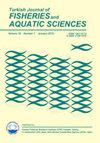Seasonal Germ Cell Proliferation and Maturation Patterns in Indian Major Carp, Labeo Rohita (Hamilton, 1822) and Tilapia, Oreochromis Niloticus (Linnaeus, 1758)
IF 1.7
4区 农林科学
Q3 FISHERIES
引用次数: 0
Abstract
The present work assessed the seasonal changes in germ cells (GC) and the maturation of rohu, Labeo rohita and tilapia, Oreochromis niloticus. Here, we showed two species representing two diverse types of spawning behavior, having two distinct GC proliferation and spawning patterns. During July, a single peak spawning season for rohu was recorded with the highest GSI (female: 19.5±1.29 and male 4.2±0.24), which is the peak monsoon time in Eastern India. However, two peak spawning seasons were marked in tilapia during the pre-monsoon (April) and post-monsoon (October) period with GSI values of male: 0.9±0.21, female: 3.9±1.32 and male: 1.1±0.3, female: 4.4±1.1 respectively. Gonadal histology in synchrony with GSI provides insights into the effects of various seasonal climate changes on the reproductive status of fish. Further, GC ultra-structure revealed various development stages in rohu and tilapia in different seasons using a scanning electron microscope. Here, comparative models were proposed for GC proliferation and maturation during different parts of the year in rohu and tilapia that may be used to plan breeding programs and hatchery management of these two species.印度大鲤鱼Labeo Rohita(Hamilton,1822)和罗非鱼Oreochromis Niloticus(Linnaeus,1758)的季节性生殖细胞增殖和成熟模式
本研究对罗虎鱼、罗贝鱼和罗非鱼生殖细胞(GC)的季节变化和成熟进行了研究。在这里,我们展示了代表两种不同类型产卵行为的两个物种,具有两种不同的GC增殖和产卵模式。7月是罗虎产卵的单峰期,GSI最高,雌鱼为19.5±1.29,雄鱼为4.2±0.24,是东印度季风的高峰期。罗非鱼在季风前(4月)和季风后(10月)有两个产卵高峰期,GSI值分别为雄:0.9±0.21,雌:3.9±1.32,雄:1.1±0.3,雌:4.4±1.1。与GSI同步的性腺组织学提供了对各种季节气候变化对鱼类生殖状态影响的见解。扫描电镜观察了罗虎和罗非鱼在不同季节的不同发育阶段。本文提出了罗虎鱼和罗非鱼在一年中不同时期GC增殖和成熟的比较模型,可用于规划这两种物种的繁殖计划和孵化场管理。
本文章由计算机程序翻译,如有差异,请以英文原文为准。
求助全文
约1分钟内获得全文
求助全文
来源期刊

Turkish Journal of Fisheries and Aquatic Sciences
FISHERIES-MARINE & FRESHWATER BIOLOGY
CiteScore
3.10
自引率
0.00%
发文量
43
审稿时长
3 months
期刊介绍:
Turkish Journal of Fisheries and Aquatic Sciences" (TrJFAS) is a refereed academic journal has been published by Central Fisheries Research Institute of Turkey and Japan International Cooperation Agency (JICA), and published in English.
It aims to address research and needs of all working and studying within the many varied areas of fisheries and aquatic sciences.
The Journal publishes English language original research papers, critical review articles, short communications and technical notes on applied or scientific research relevant to freshwater, brackish and marine environments.
TrJFAS was published biannually (April & November) between 2001 and 2009. A great number of manuscripts have been submitted to the journal for review from acceptance of the SCI index. Thereby, the journal has been published quarterly (March, June, September and December) from 2010 to 2017. The journal will be published monthly in 2018.
 求助内容:
求助内容: 应助结果提醒方式:
应助结果提醒方式:


